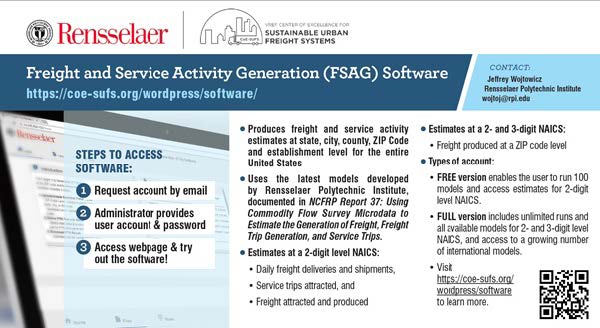United States - European Commission Urban Freight Twinning Initiative: Compendium of Project Summaries, Volume II
Overview of 2018-2019 International Urban Freight Roundtables
| Pilot | United States |
Freight and Service Activity Generation Software
The Freight and Service Activity Generation (FSAG) Software is designed to produce estimates of freight and service activities at the establishment and ZIP code level for the entire United States. It uses the latest models developed by Rensselaer Polytechnic Institute (RPI) available at "National Cooperative Freight Research Program (NCHRP) Report 37: Using Commodity Flow Survey Microdata to Estimate the Generation of Freight, Freight Trip Generation, and Service Trips" (Holguín-Veras et al., 2017). At a 2-digit level North American Industry Classification System (NAICS), the software is able to estimate daily freight deliveries and shipments, service trips attracted and freight generated at an individual establishment level and at a ZIP code, City, Metropolitan Statistical Area, and State level. In addition, it is able to estimate the amount of freight produced (in pounds per year) for 2-digit and 3-digit NAICS.

FSAG Software advertisement flyer.
Source: Rensselaer Polytechnic University.
Project Type
Pilot.
Period of Performance
January 2015 - January 2019.
Project Site
Online.
Contact
José Holguín-Veras
Professor
Rensselaer Polytechnic University
Troy, New York
JHV@rpi.edu
(518) 276-6221
Topics Addressed
- Curbside delivery.
- Economic competitiveness.
- Last mile delivery.
- Logistics/distribution.
- Mobility/congestion.
- Modeling.
- Supply chains.
Key Outcomes
The final deliverable is the software itself and it is already developed and available online. The functionalities have been improved to provide estimates at different geographical areas (ZIP code, county, city, and State).
Stakeholder Involvement
The stakeholders, such as consultants and public sector planners, were given free accounts for the demo version. Estimates from the software have been used to facilitate policy-making for NYCDOT. All stakeholders involved have provided important feedback that has been applied to the software.